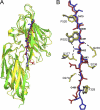Structural and biochemical characterization of Staphylococcus aureus clumping factor B/ligand interactions
- PMID: 21543319
- PMCID: PMC3138276
- DOI: 10.1074/jbc.M110.217414
Structural and biochemical characterization of Staphylococcus aureus clumping factor B/ligand interactions
Abstract
Clumping factor B (ClfB) from Staphylococcus aureus is a bifunctional protein that binds to human cytokeratin 10 (K10) and fibrinogen (Fg). ClfB has been implicated in S. aureus colonization of nasal epithelium and is therefore a key virulence factor. People colonized with S. aureus are at an increased risk for invasive staphylococcal disease. In this study, we have determined the crystal structures of the ligand-binding region of ClfB in an apo-form and in complex with human K10 and Fg α-chain-derived peptides, respectively. We have determined the structures of MSCRAMM binding to two ligands with different sequences in the same site showing the versatile nature of the ligand recognition mode of microbial surface components recognizing adhesive matrix molecules. Both ligands bind ClfB by parallel β-sheet complementation as observed for the clumping factor A·γ-chain peptide complex. The β-sheet complementation is shorter in the ClfB·Fg α-chain peptide complex. The structures show that several residues in ClfB are important for binding to both ligands, whereas others only make contact with one of the ligands. A common motif GSSGXG found in both ligands is part of the ClfB-binding site. This motif is found in many human proteins thus raising the possibility that ClfB recognizes additional ligands.
Figures






Similar articles
-
Clumping factor B, a fibrinogen-binding MSCRAMM (microbial surface components recognizing adhesive matrix molecules) adhesin of Staphylococcus aureus, also binds to the tail region of type I cytokeratin 10.J Biol Chem. 2004 Dec 3;279(49):50691-9. doi: 10.1074/jbc.M408713200. Epub 2004 Sep 22. J Biol Chem. 2004. PMID: 15385531
-
Crystal structures reveal the multi-ligand binding mechanism of Staphylococcus aureus ClfB.PLoS Pathog. 2012;8(6):e1002751. doi: 10.1371/journal.ppat.1002751. Epub 2012 Jun 14. PLoS Pathog. 2012. PMID: 22719251 Free PMC article.
-
Identification of the Staphylococcus aureus MSCRAMM clumping factor B (ClfB) binding site in the alphaC-domain of human fibrinogen.Microbiology (Reading). 2008 Feb;154(Pt 2):550-558. doi: 10.1099/mic.0.2007/010868-0. Microbiology (Reading). 2008. PMID: 18227259 Free PMC article.
-
The MSCRAMM Family of Cell-Wall-Anchored Surface Proteins of Gram-Positive Cocci.Trends Microbiol. 2019 Nov;27(11):927-941. doi: 10.1016/j.tim.2019.06.007. Epub 2019 Jul 30. Trends Microbiol. 2019. PMID: 31375310 Review.
-
Structural and functional role of Staphylococcus aureus surface components recognizing adhesive matrix molecules of the host.Future Microbiol. 2009 Dec;4(10):1337-52. doi: 10.2217/fmb.09.102. Future Microbiol. 2009. PMID: 19995192 Review.
Cited by
-
Molecular Characterization of the Multiple Interactions of SpsD, a Surface Protein from Staphylococcus pseudintermedius, with Host Extracellular Matrix Proteins.PLoS One. 2013 Jun 21;8(6):e66901. doi: 10.1371/journal.pone.0066901. Print 2013. PLoS One. 2013. PMID: 23805283 Free PMC article.
-
Streptokinase Treatment Reverses Biofilm-Associated Antibiotic Resistance in Staphylococcus aureus.Microorganisms. 2016 Sep 20;4(3):36. doi: 10.3390/microorganisms4030036. Microorganisms. 2016. PMID: 27681928 Free PMC article.
-
Protein structure prediction in the era of AI: Challenges and limitations when applying to in silico force spectroscopy.Front Bioinform. 2022 Oct 7;2:983306. doi: 10.3389/fbinf.2022.983306. eCollection 2022. Front Bioinform. 2022. PMID: 36304287 Free PMC article.
-
Adhesive Virulence Factors of Staphylococcus aureus Resist Digestion by Coagulation Proteases Thrombin and Plasmin.ACS Bio Med Chem Au. 2022 Dec 21;2(6):586-599. doi: 10.1021/acsbiomedchemau.2c00042. Epub 2022 Sep 2. ACS Bio Med Chem Au. 2022. PMID: 36573096 Free PMC article.
-
Prevalence and distribution of adhesins and the expression of fibronectin-binding protein (FnbA and FnbB) among Staphylococcus aureus isolates from Shahrekord Hospitals.BMC Res Notes. 2019 Jan 22;12(1):49. doi: 10.1186/s13104-019-4055-0. BMC Res Notes. 2019. PMID: 30670071 Free PMC article.
References
-
- Diekema D. J., Pfaller M. A., Schmitz F. J., Smayevsky J., Bell J., Jones R. N., Beach M. (2001) Clin. Infect. Dis. 32, S114–S132 - PubMed
-
- Lowy F. D. (1998) N. Engl. J. Med. 339, 520–532 - PubMed
-
- Chambers H. F. (2009) J. Infect. Dis. 199, 291–293 - PubMed
-
- von Eiff C., Becker K., Machka K., Stammer H., Peters G. (2001) N. Engl. J. Med. 344, 11–16 - PubMed
Publication types
MeSH terms
Substances
Associated data
- Actions
- Actions
- Actions
Grants and funding
LinkOut - more resources
Full Text Sources
Molecular Biology Databases
Research Materials

